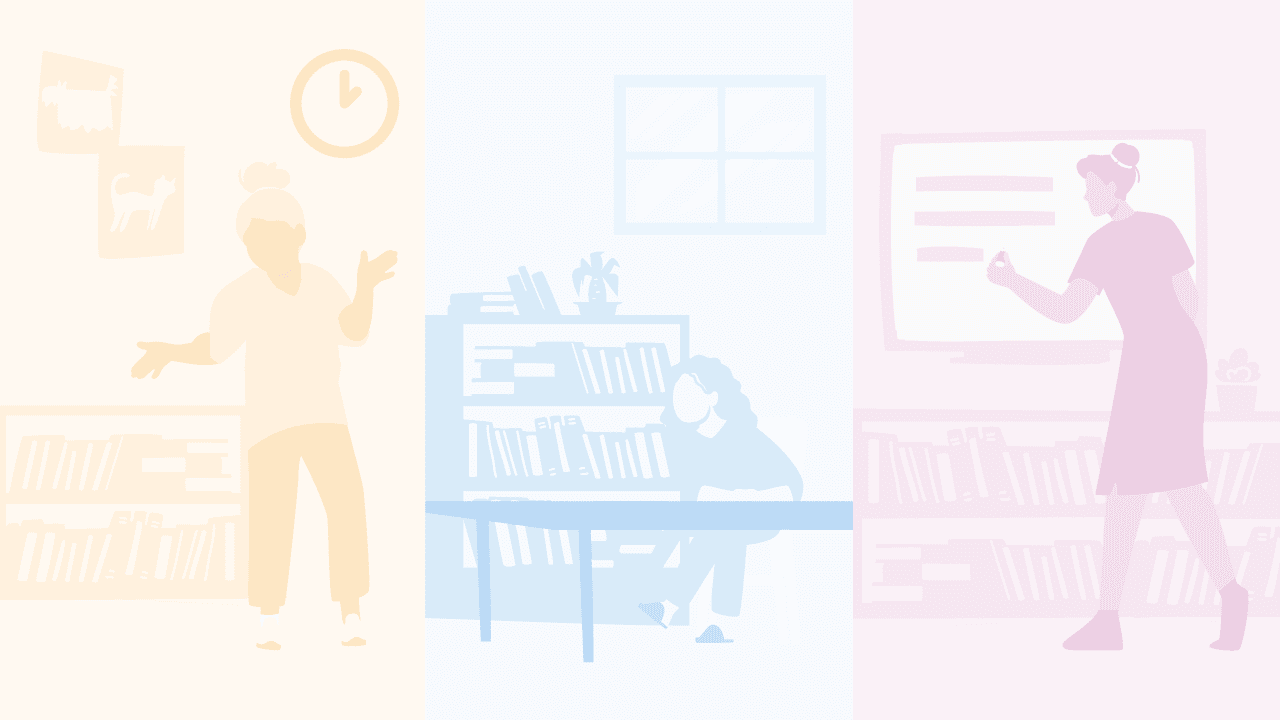How many days of school do you have left? For most of us, the answer is ”¦ not many! With the end of the year around the corner, it’s tempting to breeze through the last few weeks with little thought for your physical space. After all, your school district may have end-of-year events like testing, prom, final projects, field trips, and more. But the school year isn’t over yet, and the instructional days that remain are still important. Your classroom environment can make a big difference in how you and your students wrap up this academic year.
Here are a few quick tips to help you brighten your classroom, organize your workspace, and reflect the energy and joy of spring as you bring the year to a close.
1. Brighten Your Classroom
At school
If you’re working in a brick‑and‑mortar setting, try these tips.
Take Another Look
Has it been a while since you examined all the walls of your classroom? Take a good look. What two or three words come to mind when you look at the bulletin boards, anchor charts, posters, and other visual displays? If “old,” “faded,” or “messy” comes to mind, now’s a perfect time to brighten things up.
Clean
Start by removing the torn, discolored, and no‑longer‑relevant anchor charts and posters. Then, wipe the walls clean, working from the top down, and sanitize surfaces like desks, small‑group tables, and bookshelves. This chore might take about an hour, but if you have a co‑teacher or an assistant, you can knock it out even faster. Make it fun by listening to music while you work.
Refresh
Next, change the bulletin board background paper to a bright, bold color. You don’t need to redesign every bulletin board and visual display with new themes, but fresh new color goes a long way toward reviving the warmth and energy of your space. While you’re working on the bulletin boards, make one last update to your student work wall. Students always love seeing their work displayed—it makes them feel proud and accomplished. An update, even toward the end of the year, sends the message that you’re still paying close attention to their hard work.
Add a fresh plant to a windowsill and open the blinds if you have windows. You might also find a new, inspirational poster to hang near the front of the room. Can you find something particularly relevant to your students’ lives and interests? If so, your students will notice and appreciate it.
Involve Students as Appropriate
Certain spring‑cleaning tasks are great for involving students. You can work on life skills like organization and task analysis in real time. Model how to alphabetize a file drawer and have students help you practice filing papers. Show your students how to identify which papers can be recycled and which should be kept, and then have them clean out their own homework folders.
At Home
If you’re teaching virtually, try these fun updates.
Liven Up the Background
Post a new online meeting background to liven the color on the screen, but take care not to make it overly distracting.
If you haven’t yet had a chance to figure out how to use a green screen while teaching remotely, spend a few minutes catching up on this effective teaching tool. A quick online search will yield plenty of useful videos for how to get set up. Green screens allow for moving backgrounds, student‑created background images, downloaded still images, and more. Get creative and give it a shot!
Engage Students
When it’s time to teach, play a fun, upbeat song to mark the start and end of class, or to signal transitions from one type of activity to another.
Tell your students you’ll be changing one small thing about your appearance or background every day in a given week. Then, have fun with it—wear a funny hat one day, slightly change a green‑screen image to feature a family pet the next day, and so on. You may be amazed at their increased attention and observation.
Schedule a “show and tell” time for students to share something they’ve found in nature: flowers, greenery, sticks, rocks—anything! This short activity will help ensure you and your students prioritize spending time outside during breaks or after school. Bonus points if you can tie the nature item to your objective.
2. Energize Your Final Instructional Unit
You probably have one or two units left to teach. Have you considered slightly tweaking your instructional approach to these units? You don’t need to change much in order to reenergize, and both you and your students will enjoy learning in a new way.
For example, if you typically work through math lessons with the “I Do, We Do, You Do” model to teach new concepts, try a gallery walk one week instead. A gallery walk can be done a few different ways, but the main idea is to present visual images, problem sets, or short reading passages on the walls or screens of your classroom, in‑person or remote. Then, have students move from one “exhibit” to the next, following the prompts associated with each display. Students may work in pairs or small groups.
A gallery walk invites students to explore new concepts, wonder about ideas, and respond to meaningful problem‑solving situations with their peers. It can be done before or after explicit instruction on the learning objective. Give it a try! But remember, any time you try something new, it’s important to provide clear instruction on behavioral expectations so students know how to be successful. Offer examples of what to do and what not to do.
3. Make Your Workspace Free of Clutter
Your own workspace is just as important as the classroom in which your students are learning. This is where you lay the groundwork for magic to happen—planning, grading, brainstorming about individual student needs, and more. Even if you’re not typically known for a tidy desk, it will be a gift to your sanity at the end of the year to have a neatly refreshed workspace.
Is your desk in your classroom? Maybe it’s in a shared space, like a teacher workroom or family room at home. Or perhaps you have a cart and travel from room to room? Wherever your workspace is located, spend a few minutes tidying it up.
4. Organize Your Paperwork
Don’t be afraid to recycle things you’re sure you won’t need again, even as you err on the side of filing away templates, important documents, and other papers that you may need next year. Be sure to shred any documents that contain student information and progress, which would be considered confidential. Wherever it makes sense to do so, scan important papers so you can file them electronically—and then recycle the hard copies so you have less paper clutter.
5. Label and Sort Materials
Take stock of your filing cabinet and storage containers. Are they updated? Labeled? Functional? If not, add labels, alphabetize, and categorize as needed.
6. Tidy Up Your Digital Files
Since so much of curriculum and instruction is stored electronically, spring cleaning isn’t just for the stacks of papers and piles of things around you. It’s especially important to spend time decluttering your electronic files. Wouldn’t it be nice to be able to quickly and easily find the test, unit plan, or form you spent hours creating? You may find it particularly helpful to create clearly labeled, organized folders with unit plans and weekly lessons. This will make sharing effective lessons and ideas with peers quick and easy.
7. Update Your Resume
Finally, update your resume—even if you’re not looking for a job. It’s best practice to do this while your most recent accomplishments and data are fresh on your mind. You never know what’s in store ”¦ you may discover that a leadership role opens up within your current school that piques your interest, or your family may decide to move next year. An updated resume will be one less thing to worry about when it comes time to look for your next position or when an amazing, and sometimes unexpected, opportunity comes your way!
8. Enjoy the Fruits of Your Labor
Spring cleaning and decluttering are highly enjoyable to some and absolutely dreaded by others. Wherever you fall along this spectrum, they’re still helpful, fruitful tasks. Teachers and students reap the benefits of a bright, clean, organized space to think and learn. Creating a fresh, clutter‑free classroom is a great way to take steps toward summer, and you’ll appreciate your efforts when you return for the new school year. Happy spring!



